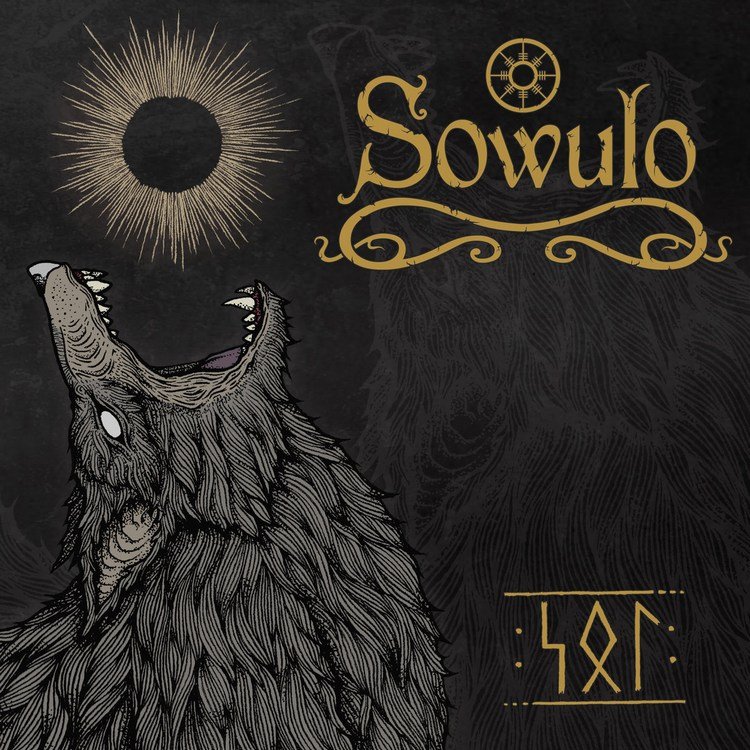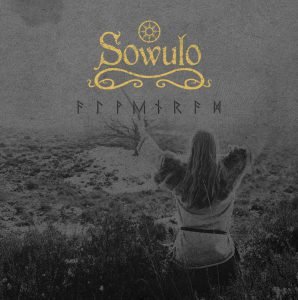
When I started as a reviewer for CeltCast in the autumn of 2017, I wrote several reviews in one go. Most of them are published, but two were put on the shelf for later use. As is common with stuff on shelves, they were forgotten, collecting dust in a dark corner of my laptop. Now, with Sowulo already recording their third album, I dug the review of Sol up again. We finally focus our attention to Sowulo’s second album, and everything which happened before that, because you can’t introduce Sol without mentioning their first CD Alvenrad. So we start the story with that album, taking us all the way back to 2010.
 In 2010 Faber Horbach started developing the concept of what would become Sowulo – a project named after the Germanic rune for the Sun – and started composing the music for what would become the Alvenrad album. An album Sowulo described back then as ambient folk music inspired by Germanic mythology. The name Alvenrad came from the Germanic name for the sun and the album was a celebration of the pagan year festivals. Nowadays Sowulo refers to this CD as ritual music.The album came out in 2012 and the band members were, besides Faber Horbach on piano and chant, Klaartje van Zwoll on violin and chant, Koen van Egmond
(SeeD)
on flute and Tom Latten on percussion. The recordings were done by Fieke van den Hurk.
In 2010 Faber Horbach started developing the concept of what would become Sowulo – a project named after the Germanic rune for the Sun – and started composing the music for what would become the Alvenrad album. An album Sowulo described back then as ambient folk music inspired by Germanic mythology. The name Alvenrad came from the Germanic name for the sun and the album was a celebration of the pagan year festivals. Nowadays Sowulo refers to this CD as ritual music.The album came out in 2012 and the band members were, besides Faber Horbach on piano and chant, Klaartje van Zwoll on violin and chant, Koen van Egmond
(SeeD)
on flute and Tom Latten on percussion. The recordings were done by Fieke van den Hurk.Looking back at this period Faber Horbach explains: ‘I did indeed compose Alvenrad all by myself.The concept of Alvenrad was the sun, the four seasons and the pagan festivals that go with it. The subtitle of the CD was: celebrating our great pagan legacy. The whole idea was born out of my own wish to be able to play appropriate music to the specific pagan festivals we celebrate nowadays. The music on Alvenrad is therefore dedicated to those yearly festivals and the wheel of life, the way nature evolves during a year, because these are universal themes within paganism.
 I didn’t restrict myself to a Germanic or Celtic view on those festivals. We don’t exactly know how they were celebrated anyway. Instead I let myself be influenced by the different ‘feel’ of those festivals and tried to express that in my compositions.
I didn’t restrict myself to a Germanic or Celtic view on those festivals. We don’t exactly know how they were celebrated anyway. Instead I let myself be influenced by the different ‘feel’ of those festivals and tried to express that in my compositions. Funny story is, when I started recording Alvenrad at Fieke van den Hurk’s Orchus studio – the predecessor of the Dearworld studio – I had just gotten all the musicians that I needed together. In the studio I worked with all of them on their parts separately. It was only after recording Alvenrad that they all came together for the first time to shake hands. In that meeting the idea was born to try and play the music live. That’s how Sowulo as a band came together.’
As Faber explained Alvenrad is a concept album themed around the neopagan festivals. The CD is divided into four sections; winter, spring, summer and autumn, ending with the song Winter Solstice to complete the circle again. Every section starts with a sound sample setting the season. Be it footsteps in the snow, the crickets in the full summer sun or the thunder of an autumn storm. In between there are eight songs representing all the pagan festivals, Yule, Imbolc, Ostara, Beltane, Litha, Lammas, Mabon and Samhain. Although they are all separate songs, I cannot listen to them as such. In my eyes Alvenrad is a paganfolk / classical symphony with a continuous flow. Every piece has its time and place within the whole composition.
Yule and Imbolc start the CD of in a classical style, the piano setting the tone of the music, with the violin and the wind instruments weaving in their melodies. It’s the percussion and the chants that stops you from seeing this as pure modern classical music. That balance between the two is maintained throughout the album, although the ritual folk influences get stronger and stronger as Alvenrad continues, building up to the beautiful climax of Lammas and the darker but equally beautiful Mabon.
It was with this CD that I fell in love with Fieke‘s recording talents. Just as with Cesair‘s Dies, Nox Et Omnia she gave Alvenrad a powerful damatic orchestral sound that fits so well with the music and the idea behind the album. If you love classical music and instrumental ritual pagan folk This is a CD you want to have in your collection.
 Fast forward 4 years. Pan Bartkowiak became the new percussionist and Celtic harp player Chloe Bakker also joined the band. In this configuration Sowulo recorded their second album Sol. A CD with 7 new compositions and 6 that we know from Alvenrad, the songs Beltane, Ostara, Imbolc, Yule, Mabon and Lammas. So the big question beforehand was, is Sol a pimped up mini CD. Well the answer is a definitive no.
Opening track Noodlot (fate) picks up where Alvenrad stopped. It is a slow, classically influenced duet between flute and violin, with percussion and choir giving it that ritual pagan feel again. Ginnungagap, the second song, starts in a similar way, introducing Chloé on harp, but it’s Koen van Egmond who is the star in this song. His beautiful flute melodies just dance through the music, absolutely beautiful, especially when Klaartjes viola joins him for a musical pas de deux. One of the highlights on Sol.
Fast forward 4 years. Pan Bartkowiak became the new percussionist and Celtic harp player Chloe Bakker also joined the band. In this configuration Sowulo recorded their second album Sol. A CD with 7 new compositions and 6 that we know from Alvenrad, the songs Beltane, Ostara, Imbolc, Yule, Mabon and Lammas. So the big question beforehand was, is Sol a pimped up mini CD. Well the answer is a definitive no.
Opening track Noodlot (fate) picks up where Alvenrad stopped. It is a slow, classically influenced duet between flute and violin, with percussion and choir giving it that ritual pagan feel again. Ginnungagap, the second song, starts in a similar way, introducing Chloé on harp, but it’s Koen van Egmond who is the star in this song. His beautiful flute melodies just dance through the music, absolutely beautiful, especially when Klaartjes viola joins him for a musical pas de deux. One of the highlights on Sol. It took till the third song, Skoll, for me to finally realise what the big difference between Alvenrad and Sol is. The lack of piano. Faber changed his piano for the bouzouki, the hammered dulcimer and the nyckelharpa, wich gives a totally different, much opener sound. Skoll even has some Eastern European, Irfanesque moments in it. Songs like Beltane, Lammas or Mabon, that sounded really dramatic on Alvenrad, now have a more cheerful, springlike bounce to the music, while keeping the spiritual message.
Listening to the rearranged songs it becomes clear Sowulo wants us to celebrate those ancient festivals, dance on them. Whereas on Alvenrad we were invited to join in the sacred circle, hand in hand, closed eyes, with the druids leading us in chant through the greatness that is life.
 The band themselves describe Sol as: ‘Much more energetic than the first album.’ and I totally agree. Asking Faber about this he replied: ‘With the re-recording of some of songs on Sol we did change the tempo and even the key they were played in. Some parts have been rewritten and parts have been added as well. The idea was to make it sound less melancholic, more happy, free and dynamic. A bit more ‘grounded’ in a way. For me it’s important that people know that, although the music on both CDs is inspired by the pagan traditions of the old Northern European cultures, it is music meant for the ‘now’! It is music made for modern people who feel inspired by those old traditions.’
The band themselves describe Sol as: ‘Much more energetic than the first album.’ and I totally agree. Asking Faber about this he replied: ‘With the re-recording of some of songs on Sol we did change the tempo and even the key they were played in. Some parts have been rewritten and parts have been added as well. The idea was to make it sound less melancholic, more happy, free and dynamic. A bit more ‘grounded’ in a way. For me it’s important that people know that, although the music on both CDs is inspired by the pagan traditions of the old Northern European cultures, it is music meant for the ‘now’! It is music made for modern people who feel inspired by those old traditions.’
The last two songs on Sol: Arvakr and Alsvidr clearly have a different feel than the rest of the album. They are Swedish dancesongs featuring, besides Koen on flute and Pan on percussion, the nyckelharpa, giving Sowulo’s music a whole new dimension, more towards Oliver S Tyr’s project Kaunan. Will this be the direction Sowulo is gonna take on the next album? Only time will tell.
A year after writing this review I’m still in love with both CD’s. Which one I prefer mostly depends on the mood I am in. On a sunny day when I want to celebrate life, I turn to the more cheerful ‘pagan folk meets chamber music’ album Sol. On that cold winter morning, when I want to sit, be carried away and re-energized, I put on the more classical, ritual music of Alvenrad. Either way, both are well worth adding to your collection.
-Cliff
-editor Diane
-pictures taken at Castlefest, winter 2016 and Summer 2018, by Cliff de Booy photography